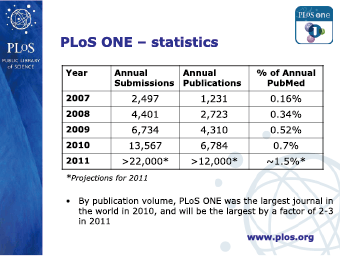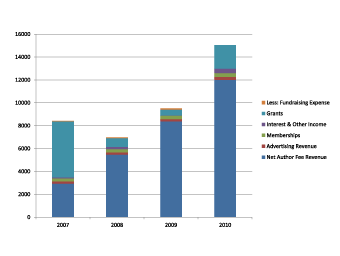Shigeki Sugita
(Librarian, Otaru University of Commerce)
● Introduction

Figure 1: Number of papers published on PLoS ONE
Last summer when I was researching something on the Internet, I came across a slide presentation. It was titled “PLoS ONE and the Rise of the Open Access Mega-Journal”1 and was authored by Peter Binfield, who at the time was a PLoS ONE publisher.
The contents of the presentation astonished me.
PLoS ONE is an open access journal launched in 2006. In 2007 it made available some 1,231 academic papers. The number was expected to exceed 12,000 in 2011 (Figure 1; that was Binfield’s estimate; in fact, PLoS ONE published around 14,000 papers that year).
Around the same time I was busy translating Stevan Harnad’s Internet posting that came to be known as “The Subversive Proposal”2 of academic publishing. A well-known advocate of open access, Harnad wrote the proposal in 1994. The gist of his proposal is as follows.
・ Harnad wanted to hasten the day when academic works would no longer be published on paper media.
・ It does not make sense for researchers to be selling their papers because it is not their aim to make money from them. The object is to make their research results available to others.
・ In the past, paper publication was the only option for making a work public. That came with corresponding expenses.
・ Today, however, they have another option, self-archiving on file servers.
・ Everyone should put their papers on servers making them accessible from anywhere in the world. The high-energy physics preprint server founded by Paul Ginsparg is one example of how this can be done.
・ The only remaining issue is quality management by peer review.
・ The total cost of scholarly publication will drop significantly and be optimized to the minimum necessary costs.
In 1994 the Web was still in its infancy. Today’s concept of e-journals did not yet exist. It would take quite a bit of imagination for us to understand the kind of future Harnad envisioned in his day. What is an academic information distribution system optimized to the minimum necessary costs? And how does PLoS ONE, with its dramatic growth, relate to this?
● Open Access Mega-Journals

Figure 2: Sources of PLoS income (based on Progress Report)
PLoS One was launched in 2006 by the Public Library of Science (PLoS), a publishing organization that issues seven open access journals, mainly in the field of life sciences. It started out with a grant from the Gordon and Betty Moore Foundation. According to the PLoS Progress Report,3 the service became profitable in 2010. This is attributed to the powerful growth of PLoS ONE. The PLoS ONE article processing charge (APC) is US$1,350. Figure 2 shows the extent to which net author fee revenue for the seven publications, including these charges, accounts for overall PLoS revenue.
PLoS ONE, a driver of PLoS profitability, is characterized as follows.
“Fast, efficient, and economical, publishing peer-reviewed research in all areas of science and medicine. The peer review process does not judge the importance of the work, rather focuses on whether the work is done to high scientific and ethical standards and is appropriately described, and that the data support the conclusions.”
“Combining tools for commentary and rating, PLoS ONE is also a unique forum for community discussion and assessment of articles.”4
One of the innovative aspects is first of all the simplifying of the peer-review process resulting in faster processing. As long as a paper is academically sound, it is published without passing judgment on the importance of its findings. Assessment of its academic worth is left up to the readers. This policy enables the service to publish 14,000 papers annually (or more than 50 a day, if this number is simply divided by 250 weekdays per year).
Thanks to the streamlining of peer review and the economy of scale from large-volume handling, the PLoS ONE APC at US$1,350 is less than half that for the flagship journals of PLoS Biology and PLoS Medicine (US$2,900).
As a result, its status as a “periodical” has largely faded.
Bibliographic information about PLoS ONE journals is given as in the example below.
Citation: Gargouri Y, Hajjem C, Larivière V, Gingras Y, Carr L, et al. (2010) Self¬Selected or Mandated, Open Access Increases Citation Impact for Higher Quality Research. PLoS ONE 5(10): e13636.”
doi: 10.1371/journal.pone.0013636

Figure 3: Word cloud of PLoS ONE papers by subject area
Table 1: Mega-journals mentioned by Binfield (The cumulative number of papers is as of July 2012, when this article was written.)
| Title |
Founded |
Cumulative papers |
| G3 (Genetics Society of America)
|
2011 |
147 |
| BMJ Open |
2011 |
457 |
Scientific Reports
(Nature Publishing Group) |
2011 |
503 |
AIP Advances
(American Institute of Physics) |
2011 |
442 |
| Biology Open (Company of Biologists) |
2011 |
92 |
| Springer Plus |
2012 |
7 |
| The Scientific World JOURNAL (Hindawi) |
2001 |
3,332 |
QScience Connect
(Bloomsbury Qatar Foundation) |
2011 |
11 |
| SAGE Open |
2011 |
97 |
| F1000 Research |
not yet |
- |
Here the “5(10)” has the appearance of indicating “Vol. 5, No. 10.” In fact, however, PLoS ONE issues no monthly journals. During a given day, dozens of papers are published on average by PLoS ONE whenever they are ready. Here “5(10)” simply refers to the prosaic fact that the paper was issued in October of the fifth year (2010) since the journal’s founding; this notation was added on later for purposes of grouping.
A feature of the service is the wide coverage extending across “all disciplines within science and medicine.” The published papers are mainly in the various life sciences but also include physics, mathematics, and other topics (Figure 3). This aspect sets it apart from traditional academic journals that are highly specialized, focusing on a narrow range of topics.
In February 2012, Binfield appeared as a lecturer at the 5th SPARC Japan Seminar 2011. Noting that journals with similarities to PLoS ONE were lately being launched by commercial publishers and by academic societies, he called these “Open Access Mega-Journals” (hereafter “mega-journals”).
David Lewis5 (2012) predicts that open access “could account for 50 percent of the scholarly journal articles sometime between 2017 and 2021, and 90 percent of articles as soon as 2020 and more conservatively by 2025.” Citing this prediction, Binfield envisions a future in which a very large number of papers are published by a small number of mega-journals.
● Variations in Ways of Distributing Academic Papers
Mega-journals seem vastly different from the traditional academic journals that we normally call journals.
A variety of media for distributing academic papers has been created with the rise of the open access movement. What are the characteristics of each? How are the various media similar? How do they differ?
Please indulge me in a quick-and-dirty mental exercise below (Table 2).
Table 2: Variations in methods of distributing papers and features of each
|
Four basic functions of academic journals |
Subject
granu-
larity |
Perio-
dicity |
Author
burden |
Reader
burden |
Registra-
tion |
Certifica-
tion |
Dissemi-
nation |
Archiving |
| (1) Subscription-based journals |
○ |
○ |
△ |
○ |
○ |
○ |
× |
○ |
| (2.1) Completely free |
○ |
○ |
○ |
○ |
○ |
○ |
× |
× |
| (2.2) Authors pay, free to readers |
○ |
○ |
○ |
○ |
○ |
○ |
○ |
× |
| (2.3) Hybrid scheme |
○ |
○ |
○ |
○ |
○ |
○ |
○ |
○ |
| (2.4) Available for free after a certain period |
○ |
○ |
○ |
○ |
○ |
○ |
× |
○/× |
| (2.5) Only online edition free |
○ |
○ |
○ |
○ |
○ |
○ |
× |
○/× |
| (3.1) Author’s website |
× |
× |
○ |
× |
× |
× |
× |
× |
| (3.2) Subject-specific repositories |
○ |
× |
○ |
○ |
△ |
× |
△ |
△ |
| (3.3) Academic institutional repositories |
× |
× |
○ |
○ |
× |
× |
△ |
× |
| (3.4) Subsidizing institutional repositories |
× |
× |
○ |
○ |
× |
× |
× |
× |
| |
| (4) Mega-journals |
○ |
△ |
○ |
○ |
△ |
× |
○ |
× |
On the left I have classified the various media into three main categories: (1) are traditional subscription-based academic journals. (2) are open access journals (so-called Gold OA) arranged based on the five types identified by Shinji Mine6 (2007). (3) are typical means of self-archiving (Green OA). Mega-journals are added as (4).
Disclosing obtained knowledge to the world (Registration), guaranteeing its scientific value (Certification), spreading the information widely (Dissemination), and passing it on to future generations (Archiving)—these have been the four basic functions of academic journals since the days of Henry Oldenburg in the 17th century. They are given on the horizontal axis along with some peripheral qualities.
(1) Subscription-based journals
These mostly provide the four basic functions. As long as they are paid subscriptions, however, the contents are not available to all. This is the reason for not giving full points for Dissemination, which is at the heart of the open access concept.
Subject granularity is generally fine, and the journals are issued based on a firm concept of periodicity. Costs are covered by readers as the price of subscription.
(2) Open access journals (Gold OA)
All four basic functions are provided, subject granularity is generally fine, and the journals are issued based on a firm concept of periodicity.
The five types of open access journals are classified according to the means by which open access is achieved. “Completely free” journals are published with the support of universities, research institutions, research funding organizations and the like. “Authors pay, free to readers” journals are, as the name would indicate, paid for by article processing charges (APC) from authors. “Hybrid scheme” journals (which I strongly hesitate to call “open access”) are subscription-based journals that charge an additional APC fee to authors who wish to make their own contributions available by open access. The remaining two types are structured such that a small number of well-off readers bear the costs so that everyone else can enjoy open access.
“Available for free after a certain period” (e.g., HighWire Press) journals make only back numbers available as open access, paid for by institutions subscribing to current articles. “Only online edition free” (e.g., Hindwai) journals cover the cost of an open access online edition by charging institutions for subscriptions to the bound edition.
Mega-journals may be classified under the type, “Authors pay, free to readers”; however, their special nature will be discussed not here but later below.
(3) Self-archiving (Green OA)
Here I would like to take a close look at the function of repositories as a place for secondary publication of papers carried in academic journals. We will not cover papers that appear first in repositories and are published only there (e.g., university research bulletins in academic institutional repositories).
The nature of repositories differs significantly from the media we have looked at up to now. First of all, with the exception of subject-specific repositories (e.g., arXiv.org) designed to secure priority rights by preprint distribution, they do not serve as a basis for establishing priority of research. A further decisive difference is that control of quality is “parasitic” on the peer-review process of the existing journal publication system (Ian Russell).7 Leaving aside the existence of author websites not intended for long-term preservation, repositories provide the functions of dissemination and archiving.
Subject-specific repositories, as their name suggests, have a clear theme awareness. The subject granularity, however, is extremely coarse, for example covering math and physics (arXiv.org) or social sciences (SSRN). Academic institutional repositories (e.g., Barrel: Otaru University of Commerce Academic Collections) and subsidizing institutional repositories (e.g., PMC), even when they happen to take on a certain color due to the fields of the researchers belonging to the institution or the fields covered by the research grants, do not have an inherent topic awareness.
Periodicity is also foreign to these archives.
As for coverage of costs, arXiv.org, a representative subject-specific repository, introduced a support system in 2010 by which operating funds are provided by high-use institutions. Operation of academic institutional repositories is paid for to a considerable extent by the universities or research institutions themselves. While none of these cases involves payment for publishing or subscribing to individual papers, the universities and research institutions can be seen as covering the operating costs as institutions. Subsidizing institutional repositories, on the other hand, are operated by research funding organizations themselves as part of their efforts to promote scholarship, so the costs are not borne by researchers or by universities or research institutions.
(4) Mega-journals
Next are mega-journals.
They guarantee quality of scholarship but not the worth of research results. The range of subjects is broad, with any area possible so long as it is natural science. In reality there are no volumes or issue numbers, as papers are published at any time on no fixed schedule. I wonder if such characteristics give mega-journals the appearance less of academic journals than of open access repositories with a low-budget, lightweight peer-review service thrown in. They can be called the place where Green OA and Gold OA converge.
The Subversive Proposal pointed to “Paul Ginsparg’s HEP preprint network” as the model for a public file server. It became the present arXiv.org. I believe, then, that mega-journals, having taken on a “quality control” function that was not yet a part of the Subversive Proposal, have come a step closer to achieving academic information distribution where the “true minimal expenses will be covered the optimal way.”
● In Conclusion
That brings us to the question. Will mega-journals bring about the “subversion” of academic publishing systems? That, however, is a separate discussion.
The percentage of papers published as open access will continue growing. Mega-journals will then play a major role. Let’s assume that this prediction will come to pass, even if it only touches the surface. There are then two possibilities for what will happen next.
(1) Subscription-based journals will wither and be driven out. The total number of distributed papers will not change.
(2) Subscription-based journals will not be driven out, but with a net increase in the number of papers that see the light of day, the total number of distributed papers will increase and the relative share of open access papers will grow.
The former can truly be called “subversion.” Which of these scenarios PLoS ONE’s rapid growth will follow is something that will need to be watched and assessed, using bibliometrics or some kind of social survey.
As for Peter Binfield, who led PLoS ONE, he recently left PLoS to found PeerJ, a membership-based journal publishing service.8 This venture will be worth watching as an attempt to shed the concept of academic journals and go beyond them.
References
|

